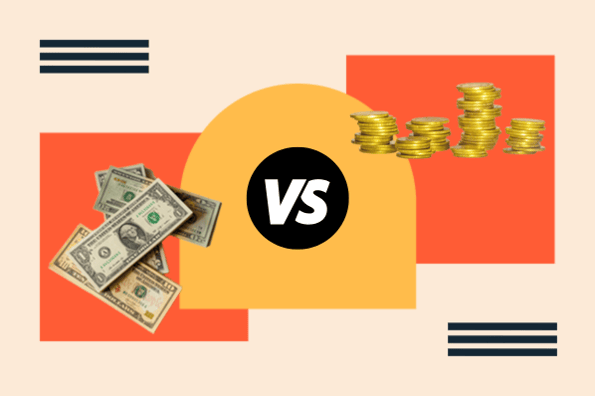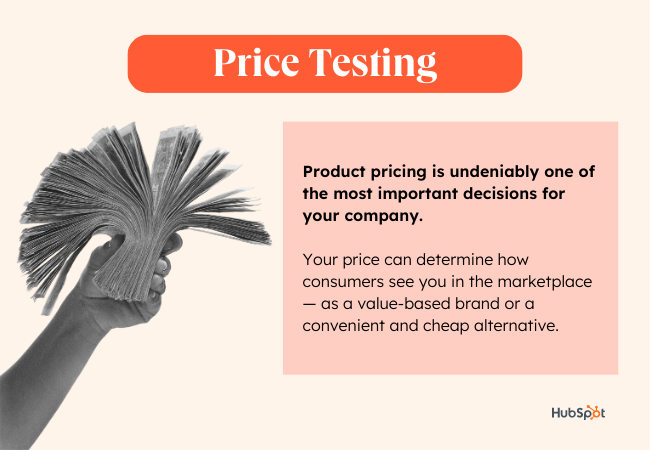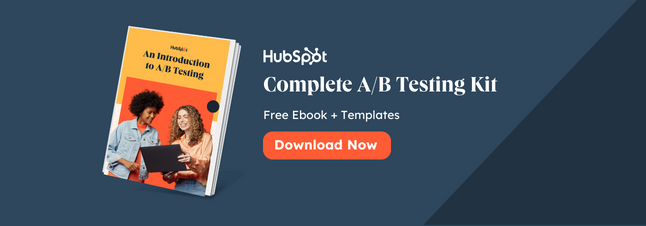How to A/B Test Your Pricing (And Why It Might Be a Bad Idea)
A/B testing the pricing for your product is a little bit like Goldilocks.

A/B testing the pricing for your product is a little bit like Goldilocks. Too high, and you could alienate the majority of your potential customers. Too low, and you won't have enough revenue to sustain your business. So how do you get it just right? That‘s what we’re going to explore in this post. We'll give you the ins and outs of A/B testing your pricing, plus some alternatives to A/B testing your pricing strategy. Price testing is when you conduct a test to determine the ideal price for attracting prospects and increasing revenue. One type of price testing is A/B testing different prices for a given product. Another type is to pilot a pricing model for one region. Product pricing is undeniably one of the most important decisions for your company. Your price can determine how consumers see you in the marketplace— as a value-based brand or a convenient and cheap alternative. There are a few other factors to consider when choosing a price, including what competitors are charging (competition-based pricing), or how much it will cost you to produce your product or service, plus how much you want to profit (cost-plus pricing). To learn more about different pricing strategies, take a look at The Ultimate Guide to Pricing Strategies. However, even once you've chosen a pricing strategy that works for your business, you might be unsure if the specific dollar price is going to return maximum revenue. For instance, your pricing strategy might show a range of $50-$60 is best for your product. However, you need to find the “sweet spot” within that range. Charge it for $50, and you might be missing out on the revenue you could‘ve received if you’d charged it at $60. Charge it for $60, alternatively, and you might limit the number of people willing to purchase your product — which could also decrease the amount of revenue you can receive. This is where A/B testing comes into play. Let's explore how to A/B test your pricing, next. It's important to note — many advise against A/B testing your pricing, for a few reasons. There are a few major disadvantages or pitfalls associated with A/B testing a price. These include: However, if you are going to A/B test your pricing, here‘s how you’ll want to do it. To ensure you‘re being ethical and fair with your prospects, you don’t want to test two different prices on the same product. Consumers will eventually catch that you‘re charging different users varying prices, and it could permanently damage your brand’s reputation. One alternative to this is testing two different products, or plans, within the same category type to see how much people are willing to pay for your product. For instance, if you sell social media software, you might choose a Basic plan and charge people $50/month. Within this plan, consumers receive 10 social accounts and 1 user. Then, you might choose your Professional plan, and charge people $140/month, which includes 20 social accounts and 2 users. By doing this, you‘re testing how much people are willing to pay for a social management tool, and whether there’s a cut-off. Technically, the Professional plan offers double the value of the Basic plan, but charges more than double each month ($140/month for 20 accounts and 2 users can be broken down to $70 for 10 accounts and 1 user — whereas a Basic plan is $50 for 10 accounts and 1 user). Then, you'll want to track if the conversion rates are higher or equal on both Basic and Professional. If there seems to be a drop-off of buyers for the Professional tool, you might want to lower your pricing on that product and see if it can positively impact revenue. You'll want to determine the prices you want to test within a given range based on a variety of factors, including competitor pricing and operational costs. You're hoping to gauge price sensitivity, or the degree to which demand changes after a certain price point. For instance, you might find if you price your product at $100, the amount of people who will purchase your product drops dramatically. Ultimately, you want to choose realistic price points to figure out the highest price you can go, while still maintaining the highest number of potential customers. A small but important detail — measure revenue, not conversions, to determine which price wins out on your A/B test. You‘ll likely have much higher conversion rates on lower-priced products, but that doesn’t mean you‘re able to hit your revenue goals. If you price a product too low, you might still struggle to meet revenue goals even with thousands of additional customers. This is why it’s important to measure revenue, not conversions. If you've tested $30/month against $50/month and found $30/month equates to the most conversions and possible revenue, consider re-testing between $30 and $40, or $30 and $35. Iterating on your results enables you to find a highly specific price point that will provide you with maximum revenue. Finally, choose the price point that suggests maximum revenue by determining the highest price that still converts enough customers to meet your business goals. If the potential risks associated with A/B testing pricing outweigh the benefits for your own business, there are plenty of alternative options to test a product's pricing. For one, you could try A/B testing the pricing page — including different layouts and CTAs — to figure out the best page for optimal conversions and monetization. Maybe your pricing isn't the issue, but your landing page is. Alternatively, if you're releasing a new product, consider launching the product in one market only to gauge market reaction and performance, before rolling the product out on a broader scale. This enables you to make tweaks to your pricing or product before releasing the product to the entire marketplace. Finally, you might consider conducting a survey and simply asking prospective customers how much they're willing to pay for a similar product in the industry. For instance, if you‘re selling a website design tool, you might ask: "What features are most important to you in a website design tool?" and, "At what point would a website design tool be too expensive?" or "What is the maximum price you’re willing to pay for a website design tool?" Ultimately, pricing is about determining your product or service‘s value, and how much consumers are willing to pay for that value. It’s an incredibly important factor to consider when running a business, but it's not always something you can A/B test without potentially losing consumers or damaging your reputation when consumers find different prices every time they visit your site. If you're set on A/B testing your pricing, there are other price testing methodologies that can be combined with A/B testing to better understand why the strategy is performing the way that it is. After using the A/B test methodology, add one of these to your research to get even better insights into what your customers want and expect from your business. The Van Mestendorp PSM methodology uses a series of survey questions to determine price sensitivity by identifying price levels that are too low (“bargain”), too high (“expensive”), and acceptable (“too expensive” and “too cheap”). Using this pricing method in action: Let's say a software company wants to launch a new subscription plan. They conduct a survey of their target customers, asking four questions: The company analyzes the responses and identifies the range of prices that the majority of customers find acceptable for the new plan. This technique is used for assessing the value customers assign to different product features and price points. Creating various product profiles and analyzing consumer preferences allows businesses to estimate price elasticity and identify the most appealing pricing structure. Using this pricing method in action: A car manufacturer is planning to introduce a new model with different customizable features. They create several hypothetical car configurations with varying feature sets and prices. Then, they get a pulse on potential customers' reactions by asking them to rank their preferences among different combinations. The analysis reveals which features and price points have the highest value to customers, helping the manufacturer determine the optimal pricing structure. The dynamic pricing approach involves adjusting prices in real-time based on factors such as demand, inventory levels, competitive pricing, and customer segmentation. By dynamically changing prices, businesses can optimize revenue and respond to market changes promptly. Using this pricing method in action: In this example, a ride-sharing company adjusts its prices based on demand and supply conditions in real-time. During peak hours or high-demand events, the prices increase to incentivize more drivers to be available, helping to meet the demand. Conversely, during low-demand periods, prices are lowered to attract more customers. This dynamic pricing strategy works because it allows for the optimization of revenue without overhauling the price of the product or service permanently. If you are interested in A/B testing your pricing, we‘d suggest using this process, plus a few alternatives and additional methodologies, to test out the design of your pricing pages or product landing pages. Perhaps by altering how you display your product’s value on a page, you'll raise the amount consumers are willing to pay. Editors Note: This post was originally published in April 2021 and has been updated for comprehensiveness. This article was written by a human, but our team uses AI in our editorial process. Check out our full disclosure to learn more about how we use AI.
Price Testing

How to A/B Test Your Pricing
1. Choose two different products (or plans) within the same category type.
2. Figure out the price points you want to test.
3. Measure revenue to determine price.
4. Iterate on results and re-test two new price points, if need be.
5. Choose the price that equates to maximum revenue.
Alternatives to A/B Testing
1. Only test the product page.
2. Limit the go-to-market plan.
3. Survey your customers.
Price Testing Methods
1. Van Westendorp Price Sensitivity Meter (PSM)
2. Conjoint Analysis
3. Dynamic Pricing
A/B Test Your Pricing Without Testing Your Customers' Patience

 Troov
Troov 











![6 Tactics to Boost Ecommerce Sales [Without Discounting]](https://blog.hubspot.com/hubfs/boost-ecommerce-sales-fi%20%281%29.jpg#keepProtocol)






















